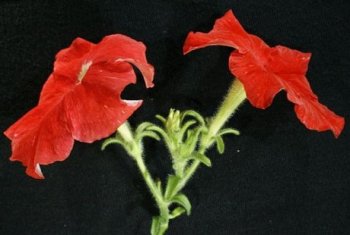
This variation is found not only in the petunias available at garden centers, but also in wild petunias. All petunia-types can often be pollinated by different insects and birds. Some are attracted to purple flowers, others to white flowers. Some fit into the smallest flowers, others can reach the nectar at the end of the long perianth.
A large international team of researchers, including scientists from Wageningen University, have now sequenced the entire genome of two different wild petunia species, and published this in the important scientific journal, Nature Plants. The sequences have shown, that the regions of DNA that contains the genes responsible for the colour and shape of flowers is very variable between the two species of petunia. One could consider this section of DNA as a ‘hotspot’ of genetic diversity compared to other less variable regions.
The petunias available at garden centers are mostly derived from a hybridization event (or genetic cross) between two wild varieties of petunia: Petunia axillaris and Petunia inflata. The hybrid petunia is, very appropriately, named Petunia hybrida.
Over the years, many different varieties of petunia were created by further crossings between these hybrids and selection of particular desirable characteristics. A significantly larger number of genes from the white Petunia axillaris were found in the DNA of Petunia hybrida as compared to the number of genes from the purple Petunia inflata.
The researchers state that this has something to do with the white-coloured flower of this species. The other flower colours probably show themselves more easily if plant breeders make use of the white variety in their breeding programmes.
According to the researchers, Petunia axillaris is the evolutionary descendant of an ancestor that strongly resembled Petunia inflata. The axillaris-variety was the result of a mutation in the DNA that stopped the plant from producing the purple colouration. More or less at the same time, evolution resulted in the perfume of the plant to become stronger. This made the axillaris plants more attractive to moths, while the original inflata flowers were the favourite of bees.
Published in Nature Plants
The paper in Nature Plants also shows that petunia is an excellent model system for further plant research.
The plants are easy to grow, quickly produce a new generation, and mutations are easily produced and made visible - especially in the flowers. Petunia is also a member of the Solanaceae family, which includes important food crops such as tomatoes and potatoes. Because these plant species are related, researchers and plant breeders are now able to further investigate the functions of genes in the DNA of tomatoes and potatoes as a result of the mapped DNA of petunia.
Tomatoes
Many different groups contributed to the unraveling of the petunia-DNA, each with their own interest in petunias. The Biosystematics group at Wageningen looked for 'traces' of duplication or triplication of the whole genome (all the DNA). They found evidence for a DNA-triplication that was also found in tomatoes, and that is regarded as Solanaceae family-specific.
However, not all the same genes were lost in tomato or potato that were lost in petunia from their common shared ancestor during the last 30 million years of evolution. Thus, much can be learned about how tomatoes and petunias came to be different.
MiRNAs
Together with the Plant Genetics group of the Radboud University, Nijmegen, the researchers also looked at small RNAs (microRNAs, miRNAs) in petunia. miRNAs are involved in controlling the activity of genes, particularly during the development of plants. They first determined which miRNAs were present in flower buds and then mapped the corresponding genes in the petunia DNA.
The DNA sequences revealed that Petunia axillaris and Petunia inflata have many the same genes for miRNAs. This means that these genes already existed from before Petunia axillaris evolved from a Petunia inflata-like ancestor. Such genes that stay the same over a long period generally concern genes with an important function.
The petunia DNA was published in Nature Plants on 27 May 2016. Two other researchers from Wageningen University wrote an accompanying commentary.
Source: Wageningen UR



 Classifieds
Classifieds

